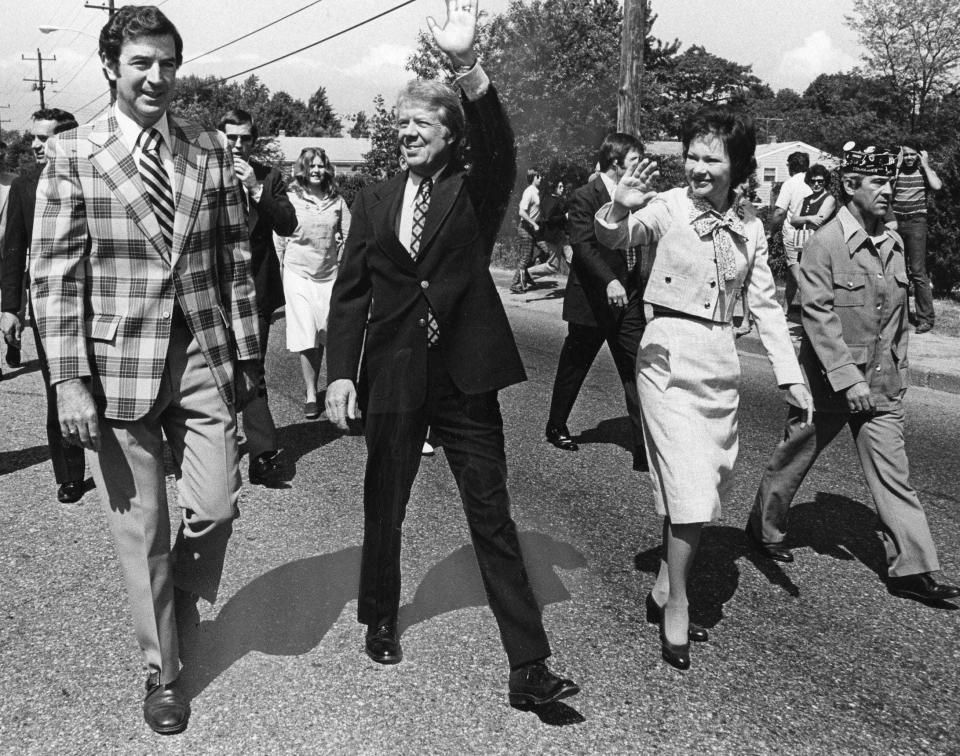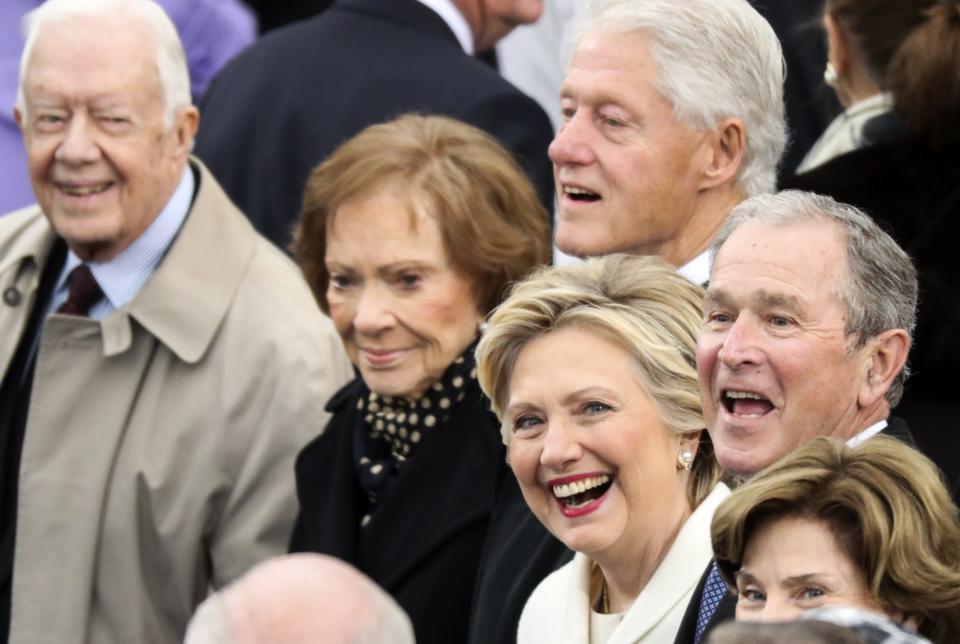Patinkin: Recalling a day in Providence with Jimmy Carter that captured his spirit
- Oops!Something went wrong.Please try again later.
- Oops!Something went wrong.Please try again later.
People will remember you, it’s said, not just for what you’ve done, but for how you made them feel.
Which is why one personal moment here in Rhode Island stands out when I think of Jimmy Carter at this time he has let the world know his journey, at age 98, is near an end.
It was September 1986, almost six years after he left the White House, beaten by Ronald Reagan after one term.
An energetic 62, Carter had come to Providence to help launch Brown University’s new Institute for International Studies.
He’d kept a low profile in previous years, stung by his defeat and still tarred by the Iran hostage crisis, so this was one of his first big appearances in a while.
But man, did he draw a crowd – 5,000 people on Brown’s main quad on a pleasant fall day. In the time of Reagan conservatism, it reflected the yearning of a progressive campus for a liberal icon, and Carter delivered, speaking passionately of human rights and decency in government.
A lion at dusk: Jimmy Carter's greatest accomplishments have been in health and welfare
Now the moment.
After his speech, various event guides and Secret Service were escorting him out one of the quad gates to the Brown president’s house for lunch when Carter spotted some schoolchildren and teachers waving his way.
Most public figures might have waved back and kept going. There was a schedule to keep. And after addressing 5,000, this was just a handful of fans.
But Carter told his handlers to hold on, then crossed the street with arms outstretched. For five full minutes – an interval that tells you a lot about the 39th president of the United States – Carter chatted with them.
He asked a few how old they were, and others if they liked school. He talked to the teachers, too, his smile and warmth authentic. It was a gift that would last. Forever, they would remember the time a president cared enough to step away from the entourage to pay attention to them.
Bruce Sundlun, then a notable corporate CEO, joined the group and told Carter, whom he’d met before, that he had “a new job.” He pointed to a “Sundlun for Governor” pin on his lapel, the start of a candidacy that would lead to two terms in the State House.
Carter smiled almost wistfully, and you wondered if it took him back to his own political journey, when he went from Navy submarine lieutenant to his family's Georgia peanut farm, then two terms in the state Senate, finally making an audacious run for governor as a champion of civil rights in a segregationist state.
I still remember how unlikely it was in 1976 that a Southern governor nobody had heard of dared to run for president against incumbent Gerald Ford.
I saw Carter on the trail that year in Utica, New York, where I had my first reporting job. The line back then was “Jimmy Who?” It seemed unlikely an obscure Southern politician who said “all” instead of “oil” would connect nationally.
He even began speeches acknowledging his low profile: “My name is Jimmy Carter, and I’m running for president.”
But one moment impressed me that day in Utica. He stopped for a press conference, and I still remember his answer to one question. Would he take vice president if it were offered?
“No.”

That’s rare. Most candidates keep that door open. But Carter said it decisively – his one goal was president. It was an interesting glimpse into the steel inside the nice guy.
That day in Providence 10 years later, I saw some of the same as I walked near his side down shady Brown Street toward the university president’s house at 55 Power. I thought he’d be glad to talk to the media, which offers 100 times the publicity of a speech audience.
But his whole focus was on regular folks who approached him. He clearly felt it imperious to ignore them in favor of a reporter. So I got the message: If you want to tag along, fine, but don’t interfere.
Yes, sir. I mean, no, sir, I won’t.
Presidential history:Jimmy Carter's presidential longevity record
In the years before his Rhode Island visit, Carter really had retreated to private life, but the Brown speech was part of a public reentry because that same week, he dedicated his presidential library in Atlanta in a big ceremony.
The library was emblematic of Jimmy Carter, then and still now. It wasn’t just a depository of papers, but positioned to address things he cared about – human rights and government decency.

Indeed, what a classy, different post-presidency Jimmy Carter has had these last 40-plus years. Unlike most, he never monetized his former office. His longtime Georgia house, where he is now spending his final days, is valued on Zillow at $223,000, well below the Georgia median price of $330,000.
Oh, he also shopped at the Dollar General and over the decades refused high-paying board membership offers.
But he was notably on one board – Habitat for Humanity – working a week a year as the country’s most famous carpenter, building homes for the needy.
'They are at peace': Jimmy Carter enters hospice care with full support of family, doctors
At first I thought hammering nails was a waste of an ex-president’s time. But he had an authentic religious side that believed in humble service, and he also understood the power of optics. He was modeling how to be a good servant and soul.
I looked up our other coverage of that day in 1986 on Brown’s quad. My gifted former colleague Wayne Worcester accurately described Carter that day as, “Jimmy with the broad, bright, white and winning smile.”
Wayne further observed: “If the more than 5,000 people who gathered on the College Green at Brown University had the chance yesterday, they might have voted him back into office.”
One might wonder if that would have been the case in more recent decades.
When I said we remember folks by how they made us feel, I meant in personal interactions. But I think Jimmy Carter managed to do something larger.
In his humble post-presidency, his interactions were with all of us. And right to the end, he affected the country in the same way he affected those kids and teachers that day in Providence.
He made us feel good about ourselves – and the nation whose values he embodied.
mpatinki@providencejournal.com
This article originally appeared on The Providence Journal: Jimmy Carter visit to Providence, RI, put his generous spirit on display
